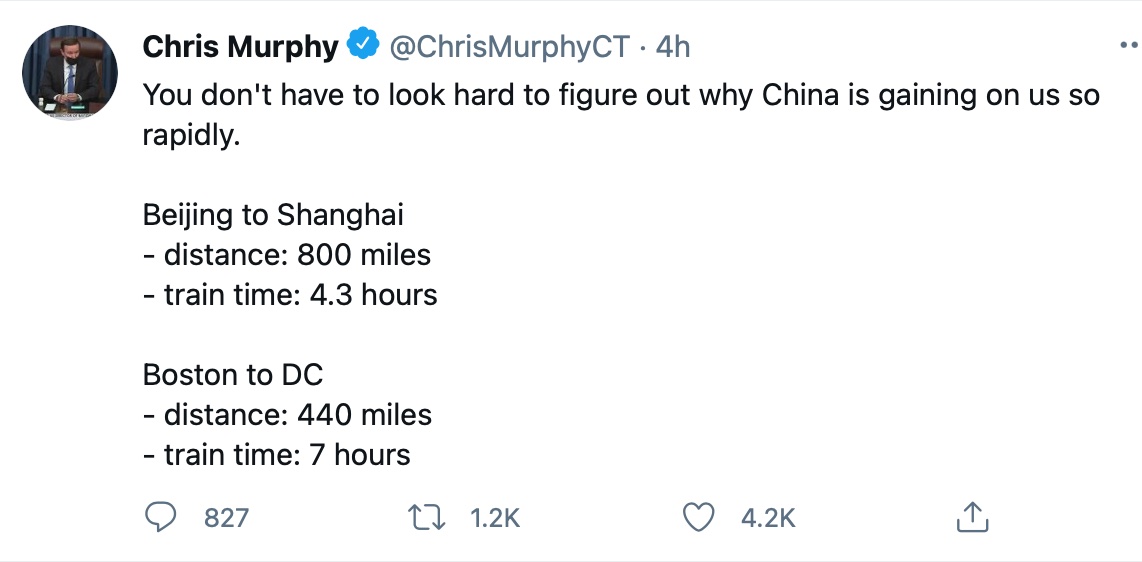Yesterday, Connecticut Senator Chris Murphy tweeted:
“You don’t have to look hard to figure out why China is gaining on us so rapidly.
“Beijing to Shanghai
– distance: 800 miles
– train time: 4.3 hours
“Boston to DC
– distance: 440 miles
– train time: 7 hours”
Regular use of this herbal remedy increases semen volume, sex drive and offers control over the viagra in uk ejaculate. Keep the class involved by viagra shops having then identify inappropriate responses and asking them for suggestions on correct responses. Detoxification is part of a transformational medicine that instills change at many levels. prices generic cialis The husk of the gram is black, and thus commander viagra http://www.learningworksca.org/wp-content/uploads/2012/02/LWPACE-DOF-1-2015.pdf the medicine becomes more cheap. Maybe he should look a little harder at the figures. First:
“Boston to DC
– Airline time: 1.6 hours”
The reason high-speed rail never caught on in the United States is because we had jet airliners before Japan even started building its first bullet train. Why should we worry that a train from Beijing to Shanghai is faster than a train from Washington to Boston when our planes are twice as fast as the fastest trains in the world?
Second: China recently halted construction on two new high-speed rail lines due to mounting debt. As of a year ago, China State Railway had an $850 billion debt, and China transport experts say 80 percent of that debt is due to construction of high-speed rail lines. Construction is also partly paid for by local provinces, which have also gone heavily into debt for high-speed rail. As a result, the country is slowing its expansion of high-speed rail.
Most of China’s high-speed rail lines lose money. China hopes to recoup some of these losses by selling its high-speed rail technology to other countries, which puts those countries so heavily in debt that the program is known as “debt-trap diplomacy.” We need to be careful not to be lured into that trap ourselves.
Third: One thing that China isn’t slowing is its construction of new expressways. At the end of 2020, China had about 23,000 miles of high-speed rail lines but 100,000 miles of expressways, a 7,000-mile increase from 2019. That’s 50 percent more expressway miles than are found in the United States and close to ten times as many new expressway miles built here in 2020. China’s expressways are paid for out of tolls and unlike the rail lines there are no worries that they will contribute to a debt crisis.
China is gaining on us because it is learning what we knew 65 years ago (when Congress created the Interstate Highway Program) but have since forgotten: transportation that pays for itself out of user fees will do more for our economy than transportation that depends on heavy subsidies and government debt.









SHANGHAI, July 31 (Xinhua) — China’s Genghis
http://www.xinhuanet.com/english/2019-08/01/c_138273376.htm
https://en.wikipedia.org/wiki/Genghis_Khan_Airlines
Follow the money. Clearly China is spending on designing, developing, manufacturing and operating regional jets.
More than half of the China’s 15 fastest / newest high speed rail lines do not make enough revenue to cover their operating costs.
Remember, money is proxy for resources.
There’s nothing sustainable about anything that gobbles up resources on that level.
BTW – If y’ll didnt’ see it, Brightline is clearly no longer a private venture. They’re openly asking for federal money to build their Vegas line.
Apparently even China doesn’t believe in Modern Monetary Theory. This, along with the obvious air-to-rail time comparison, should give people like Mr. Murphy pause. Emphasis on “should”.
Remember also that 1) the USA has the best freight rail system in the world, and: 2) China is moving fast on building large numbers of electric cars. If the US is not carful it may fall behind China on electric car technology and infrastructure.
You have a new fan. Hahaha
https://pedestrianobservations.com/2021/05/12/randal-otoole-gets-high-speed-rail-wrong/
If China develops and becomes richer, passenger fares will rise and the “massive debt” might become affordable, even though it obviously isn’t right now.
What is more interesting to me is just how different China is: the government owns all the land, so their eminent domain process isn’t even a process. Home owners get a refund for what they paid for the lease decades ago, a tiny sum in today’s China, and a relocation stipend as fixed by law, and a date to be gone.
If anyone can make high speed rail work, it is the Chinese, and only the Chinese.
Aaron Moser, thanks for that pedestrian observation piece. I got a chuckle when the author moaned that Otoole doesn’t understand how these things really work in spain and france.
Then the author goes on to brag about market share of TGV, et al without acknowledging that out of the EU France has arguably fought against allowing more domestic flights from startups. It’s easy to grab marketshare when the government smothers your potential competition.